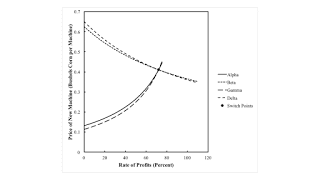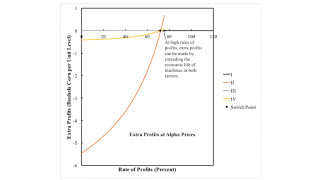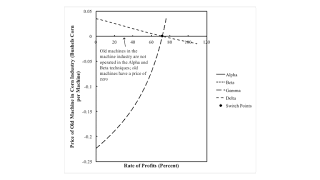Figure 1: A Wage Frontier1.0 Introduction This post presents a numberic example of a non-interlocked system with fixed capital and no superimposed joint production. This seems to be the minimum multiple-sector model: Of the production of commodities by means of comodities With both circulating and fixed capital, In which the fixed capital consists of machines of non-constant efficiency with a physical lifetime of more than one period. This is a step in my research agenda of exploring perturbations in the analysis of the choice of technique, including perturbations of fluke switch points. This post presents a fluke switch point in which four techniques are simultaneously cost-minimizing at a switch point. 2.0 Technology In this economy, firms produce machines and corn. Corn is the
Topics:
Robert Vienneau considers the following as important: Example in Mathematical Economics, Joint Production
This could be interesting, too:
Robert Vienneau writes Austrian Capital Theory And Triple-Switching In The Corn-Tractor Model
Robert Vienneau writes Double Fluke Cases For Triple-Switching In The Corn-Tractor Model
Robert Vienneau writes The Emergence of Triple Switching and the Rarity of Reswitching Explained
Robert Vienneau writes Recap For A Triple -Switching Example
| Figure 1: A Wage Frontier |
This post presents a numberic example of a non-interlocked system with fixed capital and no superimposed joint production. This seems to be the minimum multiple-sector model:
- Of the production of commodities by means of comodities
- With both circulating and fixed capital,
- In which the fixed capital consists of machines of non-constant efficiency with a physical lifetime of more than one period.
This is a step in my research agenda of exploring perturbations in the analysis of the choice of technique, including perturbations of fluke switch points. This post presents a fluke switch point in which four techniques are simultaneously cost-minimizing at a switch point.
2.0 TechnologyIn this economy, firms produce machines and corn. Corn is the only consumption good, and a bushel corn is the numeraire. Corn acts also as circulating capital. New machines and corn are final goods.
As shown in Table 1, two processes are available in the machine sector to produce two machines. One uses a new machine as fixed capital and jointly produces an old machine (with a history of having been run in the machine sector) with the new machine. The other process uses the old machine as fixed capital to produce a new machine. Both processes also require inputs of labor and corn. The corn acts as circulating capital. All processes are assumed to exhibit constant returns to scale (CRS) and to take a year to complete.
| Inputs | Process | |||
| (I) | (II) | (III) | (IV) | |
| Labor | 1/10 | 8 | 43/40 | 1 |
| Corn | 1/16 | 1/4 | 1/8 | 0.2823836 |
| New Machines | 1 | 0 | 1 | 0 |
| Old Machines - Type A | 0 | 1 | 0 | 0 |
| Old Machines - Type B | 0 | 0 | 0 | 1 |
| Outputs | ||||
| Corn | 0 | 0 | 1 | 14/25 |
| New Machines | 2 | 5/2 | 0 | 0 |
| Old Machines - Type A | 1 | 0 | 0 | 0 |
| Old Machines - Type B | 0 | 0 | 1 | 0 |
Managers of firms also know of two processes in the corn sector that can be operated to produce corn. These processes have a similiar structure as the processes in the machine sector.
Although the physical life of a machine is two years, firms are not required to operate a machine for two two years. They face a choice of technique. They can truncate the machine after one year in either sector. Consequently, they must choose among the four techniques listed in Table 2.
| Technique | Processes |
| Alpha | I, III |
| Beta | I, II, III |
| Gamma | I, III, IV |
| Delta | I, II, III, IV |
One can set up a system of equations for prices of production, as in single production technology, from the processes that are operated in a given technique. Each process contributes an equation. I assume wages are paid out of the surplus at the end of the year, not advanced. In a non-interlocking system with no superimposed joint production, the prices of old machines can be eliminated, following the approach in Sraffa's chapter on fixed capital.
In this example, this elimination will yield two equations for each technique. The variables in these two equations are the wage, the rate of profits, the price of corn, and the price of a new machine. Since corn is the numeraire, its price is unity. Given the rate of profits, one can solve for the remaining variables. Figure 1, at the top of this post, plots the wage versus the rate of profits for each technique. Figure 2 plots the price of a new machine against the rate of profits.
| Figure 2: The Price of a New Machine |
A single switch point arises in this example. The wage and the price of a new machine at the switch point are the same for all for techniques. This is a fluke.
4.0 The Choice of TechniqueIn general models of joint production, one cannot use the wage frontier to analyze the choice of technique and other properties of single production systems do not carry over. As I understand it, in models of fixed capital with certain properties and without superimposed joint production, properties of single production systems still obtain. Accordingly, Figure 1 does illustrate the variation of the choice of technique with distribution for this example.
But I want to consider an analysis that does not rely on the construction of the wage frontier. In the analysis presented here, the price of old machines enters in.
I begin by considering prices of production when the Alpha technique is in operation. No joint production occurs in the Alpha technique. Figure 3 shows extra profits obtained by each process with Alpha prices. It is not evident on the graph, but extra profits in the first and third process are zero, whatever the distribution of income. This is just a check that these prices do indeed solve the price system for the Alpha technique. For any rate of profits less than at the switch point, the second and fourth process incur extra costs. It does not pay to operate a machine for a second year in either sector. The Alpha technique is indeed cost-minimizing for this range of the rate of profits. But the Alpha technique is not cost-minimizing for larger feasible rate of profits. Operating the machine for a second year makes extra profits in both sectors.
| Figure 3: Extra Profits with the Alpha Technique |
Next, I want to consider the price of an old machine in the machine sector. Figure 4 shows how the price of such a machine varies with the rate of profits for the price systems for each technique. An old machine is operated in the machine sector under the Beta and Delta techniques. For a rate of profits below the rate of profits at the switch point, the price of this old machine is negative. The implication is that the Beta and Delta techniques cannot be cost-minimizing in this range of the rate of profits. The old machine should not be operated for the second year; its economic life should be truncated. On the other hand, the price of an old machine is the machine industry is non-negative for a rate of profits larger than the rate of profits at the switch point, whatever the technique.
| Figure 4: The Price of an Old Machine in the Machine Sector |
Figure 5 graphs the price of an old machine in the corn sector. Such a machine is operated in this sector under the Gamma and Delta techniques. We have already seen that the Beta and Delta techniques cannot be cost-minimizing for a low rate of profits. The operation of an old machine in the corn sector should be truncated at a low rate of profits under the Gamma technique. So the condition that prices of old machines cannot be negative for the cost-minimizing technique implies that the Alpha technique is uniquely cost-minimizing at rates of profits smaller than the rate at the switch point.
| Figure 5: The Price of an Old Machine in the Corn Sector |
For high rates of profits, the use of an old machine in the corn sector must be truncated under the Delta technique. In fact, at Beta prices, the operation of an old machine in the corn sector incurs extra costs at high rates of profits. At Gamma prices, the operation of an old machine in the machine sector makes extra profits at high rates of profits. So from Figure 3, one knows that the Alpha technique is not cost-minimizing at high rates of profits. The Gamma technique cannot be cost-minimizing at high rates of profits, since a process (Process II) not in the technique makes extra profits. But by Figure 5, the Delta technique cannot be cost-minimizing at high rates of profits. Only the Beta technique is consistent with cost-minimization at high rates of profits.
So this analysis of the choice of technique based on which processes make extra profits, for each price system, and which prices of old machines are negative justifies, for this example, the results of an analysis based on the outer envelope for the wage curves for the various techniques.
5.0 ConclusionI have briefly considered the effects of perturbations of a1, 4. For a slightly higher value, the Alpha and Beta techniques, in order of an increasing rate of profits, are cost-minimizing. For a slightly lower value, the Alpha, Gamma, and Delta techniques are cost-minimizing. This fluke switch point arises as technical progresses leads it to be worthwhile to operate the machine for two years in the corn sector.
Nevertheless, am not sure if I fully understand how this fluke case fits into my taxonomy. Furthermore, I am seeking a numerical example with this fluke case in which a fuller perturbation analysis will find a case of capital-reversing, if not reswitching.
 Heterodox
Heterodox





